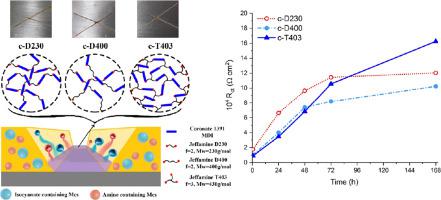Progress in Organic Coatings ( IF 6.5 ) Pub Date : 2021-07-21 , DOI: 10.1016/j.porgcoat.2021.106431 Mohammad Sadegh Koochaki 1, 2 , Rasoul Esmaeely Neisiany 3 , Saied Nouri Khorasani 1 , Ali Ashrafi 4 , Stefano P. Trasatti 2 , Mirko Magni 2

|
The effects of the healing agents' molecular characteristics were studied on the self-healing performance of the epoxy coatings via corrosion evaluation techniques. Methylene diphenyl diisocyanate (kept constant) and different polyetheramine healing agents were encapsulated separately in poly(styrene-co-acrylonitrile) through the electrospray method and added to the epoxy matrix to prepare a polyurea-based dual capsule extrinsic healing system. Commercial grades of polyetheramine, Jeffamine D230, Jeffamine D400, and Jeffamine T403, were used to study the effects of molecular weight and functionality. Scanning electron microscopy (SEM) and transmission electron microscopy (TEM) images revealed the formation of spherical shape with multicore morphology for the prepared polyetheramine containing microcapsules (MCs). Successful encapsulation was evaluated by Fourier transform infrared spectroscopy (FTIR), while the encapsulation yield was measured by thermogravimetric analysis (TGA). Electrochemical Impedance Spectroscopy (EIS) was employed to monitor the corrosion behaviour of a series of coated carbon steel samples through the evolution of the impedance spectra, and the numerical values of the related electrical equivalent circuit components (e.g., corrosion resistance), of the scratched coatings at different exposure times in a near-neutral 3.5 wt% NaCl solution. The results revealed the adverse effect on the corrosion protection ability by increasing the healing agent's molecular weight, while an increase of its functionality improved the final healing efficiency of the coating. According to the EIS results, the maximum healing efficiency was determined to be 85%, 72%, and 90% for Jeffamine D230, Jeffamine D400, and Jeffamine T403, respectively.
中文翻译:

修复剂特性对环氧涂层修复性能的影响:通过 EIS 技术评估修复过程
通过腐蚀评估技术研究了修复剂分子特性对环氧涂层自修复性能的影响。亚甲基二苯基二异氰酸酯(保持恒定)和不同的聚醚胺愈合剂是在聚分别包封(苯乙烯-共-丙烯腈)通过电喷雾方法添加到环氧树脂基质中,制备聚脲基双胶囊外源愈合系统。使用商品级聚醚胺、Jeffamine D230、Jeffamine D400 和 Jeffamine T403 来研究分子量和官能度的影响。扫描电子显微镜 (SEM) 和透射电子显微镜 (TEM) 图像显示所制备的含有聚醚胺的微胶囊 (MC) 形成了具有多核形态的球形。通过傅里叶变换红外光谱 (FTIR) 评估成功封装,而通过热重分析 (TGA) 测量封装产率。电化学阻抗谱 (EIS) 用于通过阻抗谱的演变以及划痕的相关等效电路元件(例如耐腐蚀性)的数值来监测一系列涂层碳钢样品的腐蚀行为。在近中性的 3.5 wt% NaCl 溶液中不同暴露时间的涂层。结果表明,增加修复剂的分子量对腐蚀保护能力产生不利影响,而其功能性的增加提高了涂层的最终修复效率。根据 EIS 结果,Jeffamine D230、Jeffamine D400 和 Jeffamine T403 的最大愈合效率分别确定为 85%、72% 和 90%。划伤涂层在近中性 3.5 wt% NaCl 溶液中不同暴露时间的相关等效电路元件(例如耐腐蚀性)的数值。结果表明,增加修复剂的分子量对腐蚀保护能力产生不利影响,而其功能性的增加提高了涂层的最终修复效率。根据 EIS 结果,Jeffamine D230、Jeffamine D400 和 Jeffamine T403 的最大愈合效率分别确定为 85%、72% 和 90%。划伤涂层在近中性 3.5 wt% NaCl 溶液中不同暴露时间的相关等效电路元件(例如耐腐蚀性)的数值。结果表明,增加修复剂的分子量对腐蚀保护能力产生不利影响,而其功能性的增加提高了涂层的最终修复效率。根据 EIS 结果,Jeffamine D230、Jeffamine D400 和 Jeffamine T403 的最大愈合效率分别确定为 85%、72% 和 90%。s 分子量,而其功能性的增加提高了涂层的最终愈合效率。根据 EIS 结果,Jeffamine D230、Jeffamine D400 和 Jeffamine T403 的最大愈合效率分别确定为 85%、72% 和 90%。s 分子量,而其功能性的增加提高了涂层的最终愈合效率。根据 EIS 结果,确定 Jeffamine D230、Jeffamine D400 和 Jeffamine T403 的最大愈合效率分别为 85%、72% 和 90%。











































 京公网安备 11010802027423号
京公网安备 11010802027423号